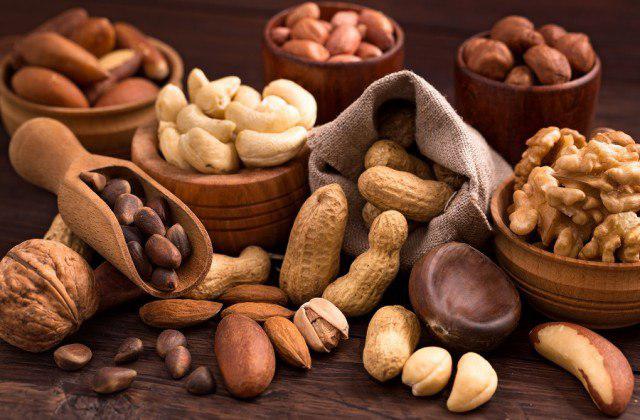- CALL US 877 221 NUTS (6887)
Why Going “Nuts” makes perfect sense

Why going “NUTS” makes perfect sense!
So – Why Go Nuts? Sometimes, health solutions are simple and effective healthcare naturally tastes great! Tree nuts represent a dense, highly nutritious source of mostly unsaturated fatty acids (predominantly oleic and linoleic acid) and protein. They also contain a plethora of known health promoting components such as antioxidants (e.g. ellagic acid), flavonoids (e.g. catechins), polyphenols, vitamins, minerals, fiber, and many more (Venkatachalam & Sathe 2006). Together, these constituents turn nuts into a nutritional powerhouse.
Historically, nuts, including their oils and milks, were used to support and improve immunity, digestion. Wound healing, circulation, pain relief, colds and phlegmatic disorders, as a diuretic, as a sleeping aid, to treat swollen glands and shingles, and more (Casas-Agustench et al. 2011). Today, known health conditions to benefit from regular nut consumption include heart disease, diabetes, metabolic syndrome, and Alzheimer’s Disease (Alasalvar & Bolling 2015). Nuts also seem to slow the ageing process and may reduce the risk of cancer, asthma, obesity. Gallstone disease, inflammatory bowel disease, and inflammatory status in general (Sweazea et al. 2014, Ros 2010).
Improved Cognitive Function
The high unsaturated fat content supports brain function by increasing serotonin (a neuro-transmitter molecule thought to play a role in depression) levels and harmonizing cerebral processes (interview with Prof Gerald Huether, German neurobiologist). Despite a lack of clinical intervention trials, observational studies indicate that long-term consumption of even small amounts of nuts may elicit benefits for cognitive function and reduction in cognitive decline (Alasalvar & Bolling 2015, Barbour et al. 2014). Anti-inflammatory medications offer some protection from Alzheimer’s disease, consistent with the hypothesis that damage to brain cells forms part of an overall inflammatory response. If inflammation is the key, then nuts containing anti-inflammatory nutrients, such as polyphenols, vitamin E and omega-3 fatty acids, may prove a very useful tool in reducing damage to the brain (Barbour et al. 2014).
Decreased Inflammation
The high content of phenolic compounds in nuts, particularly in the skin, might anticipate an anti-inflammatory effect of frequent nut consumption, as indeed some studies suggest (Ros 2010). Walnuts in particular may make better anti-inflammatory agents than other nuts, as only they contain substantial amounts of ALA, a fatty acid with higher anti-inflammatory capacity. Walnuts also exhibit high levels of ellagic acid, a phenolic compound with potent anti-inflammatory properties. While more studies are needed to conclusively resolve the question of anti-inflammatory effects of nuts, nut consumption seems to benefit the inflammatory response, as indicated by its decreasing biomarkers in the blood stream (thus suggesting reduced inflammation) (Ros 2010). Epidemiologic studies have suggested an inverse association between nut consumption and inflammation (Falasca, Casari & Maffucci 2014).
Source of Magnesium, Mg
Nuts are an excellent source of magnesium which plays an essential role in various cellular mechansims. Tumor cells frequently show an impaired Mg balance, and Mg deficiency may be associated with inflammation (Falasca, Casari & Maffucci 2014). A recent meta-analysis showed an inverse relationship between magnesium intake and the risk of developing type 2 diabetes. Acute studies revealed that almonds, taken alone or in combination with other carbohydrate-rich foods, can have a similar effect by significantly lowering blood glucose levels and insulin responses after a meal (Kendall et al. 2010).
Vitamin E & Nut Oils
Vitamin E functions as a potent antioxidant (see box 5) in cell metabolism, and is thus considered a significant health promoting component of nuts (Alasalvar & Bolling 2015). It may also play a role in lowering inflammation and improving cognitive function (Barbour et al. 2014). Hazelnuts offer higher vitamin E levels compared with other tree nuts. Nut oils also provide an excellent source of vitamin E, with hazelnut containing most, followed by pistachio, almond, pine nut, and peanut oil (Alasalvar & Bolling 2015).
The U.S. Dietary Reference Intake guideline recommends consuming c. 42 g of hazelnuts or almonds per day to achieve an uptake of c.75% and c.73% vitamin E, respectively. In other words, a handful of nuts more or less satisfies our vitamin E requirement (15 mg/ day) (Alasalvar & Bolling 2015).
Different Nuttiness Factors
Globally, the most popular and commercially important edible nuts are peanuts and several tree nuts: almond, cashew, Brazil nut, hazelnut, macadamia, pecan, pine nut, pistachio, and walnut (Venkatachalam & Sathe 2006). The following offers more specifics on health benefits associated with some select nuts.
Almonds
Almonds contain fairly high levels of vitamin E and polyphenols. Likely conferring this nut its well known antioxidant properties (Sweazea et al 2014). These authors conclude that “almond ingestion, at a typical portion size. Without other dietary modification, may be a feasible and effective diet tactic for individuals with type 2 diabetes”. As almonds do not negatively affect blood glucose, oxidative stress, or inflammation. Rather, they lowered biomarkers of inflammation (CRP) by nearly 30%. People with poorly-controlled type 2 diabetes (Sweazea et al 2014). While this looks promising, above study only included 24 participants so that confirmation from larger trials would be desirable. And remember to eat them with skin intact to retain the antioxidant benefit.
Brazil Nuts
These nuts offer a great source of the element Selenium. Se, a mineral required in trace amounts for proper cellular function. Se contributes to the body’s antioxidant systems, immune function, thyroid metabolism, and reproduction. Only one kernel (c. 5 g) supplies 174% of the recommended daily Se amount (Alasalvar & Bolling 2015).Selenium has been linked to many health benefits in humans, including decreased risk and incidence of cancer(Falasca, Casari & Maffucci 2014, Freitas-Silva & Venâncio 2011)
Walnuts
Considered one of the oldest tree fruit known to man. With records going back as far as 7000 BCE (Casas-Agustench et al. By 2011), walnuts exhibit the highest antioxidant and poly-unsaturated fatty acids content of all nuts: linoleic acid (omega-6 fat) and a-linolenic acid (ALA, an omega-3 fat) form the most prominent varieties (Vinson & Cai 2012). These walnut constituents were shown to improve inflammation. Arterial compliance, insulin resistance, and endothelial function and blood pressure in clinical and epidemiological studies. ALA is also thought to maintain cognitive function in older adults (Barbour et al. 2014). A whole food in itself, walnuts possess the highest content of ALA. Of all edible plants and also contain high levels of serotonin. Recently discovered substantial amounts of melatonin in walnuts. Also contributed a significant antioxidant effect in an experimental rat model (Ros 2010).
Another study observed the same effect after a single walnut meal (Ros 2010). A single serving (28.4g) of raw walnuts provides 575mg of polyphenols (antioxidants) which exceeds the daily sum of these antioxidants derived from fruit and vegetables combined (Vinson & Cai 2012).
Pistachios
Native to the Middle East, the pistachio tree is one of the oldest flowering nut trees. Archeological records show that pistachio consumption dates back as far as 7000 B.C. in Turkey – similar to walnuts (Dreher 2012).
Compared to other nuts, pistachios contain less fat and energy. Also higher levels of fibre, and the highest levels of potassium (K), g-tocopherol, vitamin K, phytosterols, xanthophyll carotenoids. Certain minerals (copper, iron, magnesium), vitamin B6, and thiamin. Thus, pistachios exhibit a high antioxidant and anti-inflammatory potential. Also ranking in the top 50 foods with a high antioxidant value (Bulló et al. 2015).
Mediterranean diets supplemented with 20–50g walnuts per day. 80–100g pistachios a day improved endothelial function by 21 and 24%, respectively. Pistachio consumption also improved glucose levels. Lipid parameters, oxidative status, vascular function, arterial stiffness, and some indices of inflammation. This may underlie the observed enhanced endothelial function (Kasliwal et al. 2015, Barbour et al. 2014).
Won’t I Get Fat? What About Nut Allergies?
On the contrary, they might even decrease body weight (Falasca, Casari & Maffucci 2014). Even though only a secondary outcome measure, most studies examining the effects of nuts on lipid profiles found no negative effects on body weight and showed that nuts – whether almonds, walnuts, pecans, pistachios, or peanuts – improve plasma lipid profiles and can decrease the risk of heart disease (St-Onge 2005). At the population level, multiple reviews revealed that a higher nut consumption consistently translated into a better blood serum lipid profile, and that it may reduce the risk of diabetes, without negatively affecting body weight or body weight gain over time (Russo & Siani 2012).
Nut allergies represent a severe problem for a small fraction of the populace, c. 2% of children and adolescents, tendency apparently increasing, and adults often remain sensitive.
Roasted or Raw? Salted or Plain?
Roasted nuts are delicious. Despite that, I usually prefer raw nuts, as roasted ones show a decreased antioxidant efficacy, (Bulló et al. 2015, Vinson & Cai 2012). I also feel that simple and unprocessed (raw, unsalted) is best, but that’s just a personal preference. There is evidence to the contrary, in that roasting reduces phytic acid levels of nuts. Rendering them a more tooth-friendly food than when consumed raw (Nagel 2011).
In regards to salt, here’s what Ros (2010) says: “Nuts possess an optimal nutritional density with respect to healthy minerals. Such as calcium, magnesium, and potassium. Like that of most vegetables, the sodium content of raw or roasted but otherwise unprocessed nuts is very low. A high intake of calcium, magnesium and potassium. Together with a low sodium intake, is associated with protection against bone demineralization. Arterial hypertension, insulin resistance, and overall cardiovascular risk. Obviously, the advantage of the low sodium content of nuts is lost. If they are consumed as a salted product.” Barbour et al. (2014) concur.
Conclusion
Growing evidence suggests that nut consumption improves diet quality by providing several bioactive compounds with recognized health benefits. These include glycemic control, cardiovascular health, cancer prevention, improved cognitive function, weight management, and others. And that’s Why going NUTS makes perfect sense!
Going nuts seems thus a deliciously good way to support our health. I often enjoy a handful of mixed nuts during the week and find them rather satisfying. They also make a great, energy packed tramping (hiking) snack. Five servings a week (Cohen & Johnston 2011) or 30+g per day should suffice (Barbour et al. 2014). Why not benefit from “possibly one of the most cardioprotective foods in the habitual diet” (Ros 2010)?
So: join Farmfreshnuts.com in going nuts, if you so choose! It’s gooood.


 Free Shipping
Free Shipping

